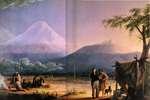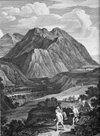| Meeting 18 • 08 March 2012 • Thursday |
Version: |
|
pictures of the week |
thought-bite of the week: |
|
|
"'I knew,' said the young Indian girl coolly, 'that the crododile would let go when I stuck my fingers in its eyes.'" |
|
mini-text of the week: "'…but the zambo would expect to be treated as an equal, and that I cannot do with a man of his colour.'" Humboldt, "Personal Narrative", from Jaguars and Electric Eels, ed. & trans. Wilson, pp. 47 (read more) |
|
(X') = anticipated time in minutes (total=75) |
(0001) etc.=item in Humboldt Project document collection |
|
Key to notes added AFTER the class meets: |
|
|
√ = topic / activity that was adequately dealt with during the class |
+ = topic that was started but needs more attention & will be resumed at next / subsequent meeting(s) |
|
- = a topic / activity that was proposed though not begun, but will be taken up later |
|
|
Italic bold green text like this = comments after the meeting |
|
|
√ |
(5') More about the thought-bite and mini-text of the week: a) Which kind(s) /cultural groups of people do you look up to / look down on? b) When have you (not: Have you ever) treated someone else as a member of a group rather than just an individual? (HERR Fischer; "brain"; "carrot-top"; "lefty"; "Missouri Sinners") |
|
+ |
(20') Sextants (Wikipedia) and earlier navigational tools - they could double as surveying instruments. 1) Hands-on primitive version (while talking like pirates, but with Franciscan prayers and rowers "singing soft, sad songs" in background); 16th-century equivalent: the backstaff (but not as primitive as our combination of trianble & carpenter's level) 2) Modern update of traditional instrument in use on relatively calm seas; explanation of use; 3) Closer look at the standard sextant of the 18th Century: the sextant Captain Cook used; 4) What Humboldt used: the (slightly high-end) tools of the time, but with the skills expected from every ship's captain and officers 5) A WWII-era sextant: its developer and basic principles; 6) Celestial navigation with instruments developed by various cultures (Polynesians, Arabs) 7) "How does X work?" - the difference between "how do you make it work" and "how it works"; example: how GPS works; more about GPS; step-by-step GPS tutorial; Free iPhone apps related to navigation demonstrations: "Skytime", "AstroCLock", "Thedolite", "Elevation", "Trig Solver" (actually does just triangles, but that's what we want), and maybe (advanced users:) "Spyglass". The same or similar apps exist for Android. Upcoming math challenge: how accurate is the "Theodolite" app? But first: How long is 1/10,000 of a degree of latitude? in feet? in meters? |
|
+ |
(10') Group projects: Report out BRIEFLY: a) title/summary; b) audience; c) intended outcome for that audience; d) notable feature (gimmick?); e) whine / shine Species descriptions: Thanks to the people who turned theirs in Tuesday - I used them immediately and people were impressed. Advice: deliver the kowledge; package the knowledge (but who is the better person to "unwrap" the package - you or the learner?); remember how closely those teachers would criticize; critical thinking: what to leave out. Contest asks schoolkids to answer, "What is a flame?" If time: Value of hands-on learning - a demonstration for math: Why, indeed, is the area of a circle calculated by squaring its radius and multiplying that by pi? |
|
+ |
(20') Contact of cultures, class of civilizations: Humboldt's pictures of Europeans in the midst of indigenous peoples, compared to his pictures of "natives". The real test: the carguero issue: what were the likely attitudes and arguments of - need to identify these - the several parties involved in that situation? What have you done in similar situations? (But first define "similar situation.") How could this be part of learning materials and experiences for Humboldt-named schools? The definition of "human" then and now - according to law, philosophy, science, culture, emotion, _____? |
|
|
(10') More about trust and sources of info: Survey: What can the educated citizen read? (periodical press; local, quotidien; long-term knowledge). Two examples: The Economist; Atlantic Monthly. How do educated citizens become capable writers? (See above: what do educated citizens read?) For specific example of a text at the "educated citizen" level, see the handout distributed at the previous meeting, "The nutrition puzzle," The Economist, February 18th, 2012, pp. 82-3). Today: small groups do fast walk-through with a marked-up version. Quite example at word level: "pervasive" and less satisfactory (semi-)synonyms (penetrating, ubiquitous, constant) |
|
(10') Checkups & Previews: Example of a reading selection ("Climbing the Redwoods") like the one you will read in preparation for the final exam. We'll discuss it at the next meeting, when you'll also receive the text that will be part of the final exam. These final two weeks: Humboldt's influence on the development of systems of land and water measurement and management in the US. Reminder: Keep your meeting handouts - maybe punch them and put them in a binder. You can also print the meeting notes from the links to the meetings on the schedule page of the course website. Where a handout includes extra material added to the printout of the meeting's web page, you'll see an additional link ("supplememtary materials") along with the link to that meeting's web page. Job / internship / volunteer opportunities: Sauvie Island Center , spring (with credit if arranged) Youth Leaders for Sustainability (various skills needed) |

